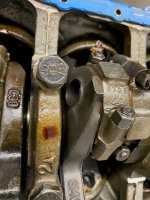Cmaxx252
Jr. Member
I'll try to keep the back story short.
The engine that came with my bronco (rebuilt and on an engine stand) does not have a spec sheet. My father (the one who purchased the engine years ago) lost the spec sheet.
The engine came with no balancer or flywheel. What he does remember from the add and talking to the owner of the engine shop that built it back then, was that it was balanced and blueprinted.
Engine casting numbers: E5AE-C3B - 1985-86 302 windsor block 2 bolt mains.
Crank casting number: 2MAE - 68-71 3.00 stroke 302 (50oz balance - external)
Dumb question incoming - With the crank being the mid 80's and 50oz, Would I be ok running my early flywheel (28oz) with my balancer set at 28oz as well?
None of the paint markings on the crank indicate a specific balance. Does that matter as long as I have the flywheel and balancer that match each other?
The weight removal holes had some flashing still on them. Is this typical with weight reduction for balance from the factory or does this look like work from a machine shop?
Do the other casting numbers mean anything? #85, C30, SMW, E7AE-AA?












The engine that came with my bronco (rebuilt and on an engine stand) does not have a spec sheet. My father (the one who purchased the engine years ago) lost the spec sheet.
The engine came with no balancer or flywheel. What he does remember from the add and talking to the owner of the engine shop that built it back then, was that it was balanced and blueprinted.
Engine casting numbers: E5AE-C3B - 1985-86 302 windsor block 2 bolt mains.
Crank casting number: 2MAE - 68-71 3.00 stroke 302 (50oz balance - external)
Dumb question incoming - With the crank being the mid 80's and 50oz, Would I be ok running my early flywheel (28oz) with my balancer set at 28oz as well?
None of the paint markings on the crank indicate a specific balance. Does that matter as long as I have the flywheel and balancer that match each other?
The weight removal holes had some flashing still on them. Is this typical with weight reduction for balance from the factory or does this look like work from a machine shop?
Do the other casting numbers mean anything? #85, C30, SMW, E7AE-AA?












